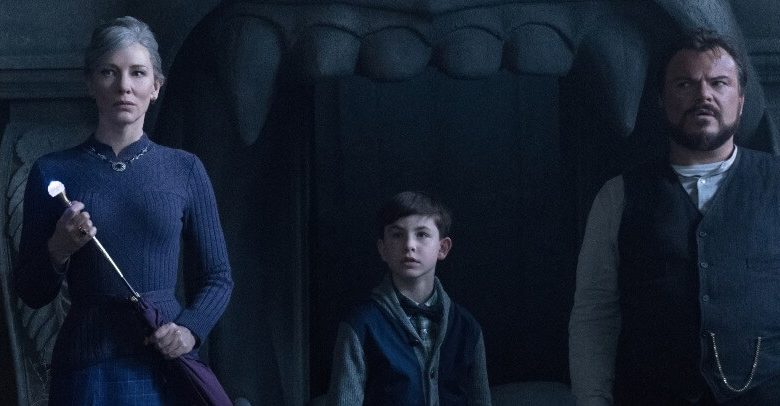‘House With a Clock’ Tinkers with PC Upgrades

It used to be that “whoever controls the past controls the future.” What does it mean when people seek to control our imagination?
Last week, “The House with a Clock in Its Walls” proved a surprise box-office topper. And while the kid-friendly film has its critics and its cuteness, the most interesting part is what it suggests about our culture.
Lead by the tenacious Jack Black and indomitable Cate Blanchett, “The House with a Clock in Its Walls” follows Lewis (Owen Vacarro), a recently orphaned boy who goes to live with his odd Uncle Jonathan (Black) in 1955. Sporting a pair of aviator goggles and wearing button-down tweeds, Lewis is more than a little nervous when he arrives at his uncle’s strange house.
Jack-o-lanterns guard the front gates year-round, and Uncle Jonathan plays the saxophone in the middle of the night.
The strangeness gets even stranger when Lewis learns that Uncle Jonathan is a warlock. His uncle, along with their purple-loving witch neighbor, Mrs. Zimmerman (Blanchett), are looking through every nook and cranny of the house for that titular clock.
That turns out to be a doomsday clock, set up by the previous house’s owner. He seeks to use the clock and his blood magic to return himself and his wife to the beginning of time, before humans came to be. They are determined to start the world over, at the cost of everything else, by any means necessary.
Critics have targeted the film for the cheesy Halloween-related scares, the general return of Black’s “School of Rock” shtick and a cynical, feminist-infused critique that sees a void left by Harry Potter fans (despite “Fantastic Beasts’” new trailer).
And, not to sound too cynical myself, there are a lot of similar appeals. “House” is a coming of age film including themes of outcasts and finding a new family after loss. There are distinct elements as well, with its take on magical fantasy and the incorporation of the steampunk genre.
It was the latter’s inclusion that intrigued me. The steampunk aesthetic combines Victorian-era fashion with a fusion of steam technology. The genre has been gaining in popularity in the last several years, with dedicated conventions, fashion lines, and television shows.
Within the movie, the steampunk style is easily seen in the various sets with pipes, cogs and clockwork items. It’s further coupled with Lewis’ outfits, his goggles and even the doomsday device workings.
But the other major tenet of the steampunk genre is in its philosophy. Often in the steampunk work, modern-day morals and values are inserted into the storyline, leading to a revised version of history.
It is the subtle historical revisionism that hints at the cultural shifts we see in America today, particularly along political lines.
While the film presents a lot of truth in the universals—the quest for acceptance among peers, the feeling of being the outcast, the desire for power to change one’s, the damages of war, the importance of who we trust, and the belief in individuality—it’s interesting to see which historical details have been altered in order to make the film more politically correct.
RELATED: Black’s Twisted ‘Polka King’ Can’t Crack American Dream
The film presents an idealized version of Michigan circa 1955, where no racial tension is present in Lewis’ school despite the Brown v. Board of Education decision handed down the previous year.
The antagonist Lewis faces in school, Tardy, lies in his election and encourages Lewis to change himself in order to be accepted by their peers.
Issues of sex and gender, such as Mrs. Zimmerman’s friendship with Uncle Jonathan and sorcery, are discussed in relation to Lewis’ habit of reading the dictionary and “boy witches,” adopting a more modern cultural position on feminism.
This would have been close to 10 years before the publication of “The Feminine Mystique.”
With the growing popularity in re-envisioned genres like steampunk, cyberpunk, time travel and alternative history, we can expect to see more of a “Longfellow Effect” on our understanding of history. We have already seen this sort of politically deceptive re-imagining in futuristic films like “V for Vendetta” and TV series like “The Handmaid’s Tale.”
While as a writer I believe you can write literally any kind of story you want, it’s now more important than ever for people to be able to determine what is real and what is false when it comes to history and culture. The culture wars in America are being fought inside the mind. Everything from movies, songs, books and even (sexist?) memes can become weapons.
Overall, “The House with a Clock in Its Walls” remains a fun adventure, one that kids 7 and up could easily enjoy with their parents. But while movies used to be, and remain, a form of escapism, a way where people could, according to Robert McKee, lose themselves to find themselves, it seems in the age of Trump, where politics influences so much of culture, the movies are more determined than ever to bring re-envisioned forms of history to life.
This is one of the reasons I believe conservatives and Christians need to create culture instead of only critiquing it. In the meantime, I’m following my own advice. If you’re interested in steampunk, please check out “One Flew Through the Dragon Heart (Favan & Flew Book 1),” a steampunk fantasy romance novel coming out in December.
C. S. Johnson is the author of several young adult novels in a variety of genres including fantasy, science fiction, and historical fiction. Her latest spy adventure, “Kingdom of Ash and Soot (Book 1),” is now available. With a gift for sarcasm and an apologetic heart, she currently lives in Atlanta with her family. Find out more at Johnson’s official Web site.
